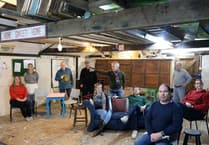THE LATE Victorian era was a time when creative people, such as artists, writers, designers and architects, discovered the beauty of the south-western part of Surrey and neighbouring East Hampshire.
Grand Edwardian mansions were built in the hills around Hindhead and in country estates around Liphook, Liss and towards Petersfield.
Throughout the area, there are many examples of buildings influenced by the Arts and Crafts movement, which developed at the turn of the 20th century.
The idea of the movement was a harking back to an idyllic rural time and to have buildings designed in that style so they were both beautiful and practical.
Typical of the larger houses was Fry’s Farm, in Liphook, which was bought by architect, garden designer and author Henry Inigo Triggs in 1910.
Around that time he wrote a number of influential books and reports on town planning and the use of landscape gardening to enhance urban areas.
He re-designed the farmhouse and gardens at his home, and renamed it Little Boarhunt, based on a legend about King John hunting boar in the district.
The house is now a Grade II listed building, being a representative romantic house of the Arts and Crafts Movement, and includes an Elizabethan-style sunken garden.
In 1912, Triggs designed the Rectory at Liphook.
He designed at least two notable houses in Nazeing, Essex.
When he was living at Liphook, Triggs was in partnership with the architect William Frederick Unsworth (1851-1912), and his son Gerald Unsworth (1883-1946).
WF Unsworth had previously designed the Shakespeare Memorial Theatre in Stratford-upon-Avon in 1879, which was destroyed by fire in 1926 and replaced in 1932 with the present Royal Shakespeare Theatre.
In 1905, WF Unsworth bought the house Restalls in Church Road, Steep, and began he and his son’s association with buildings around the town.
Triggs had begun his professional life as a garden designer and he became the link between the Arts and Crafts houses in Steep when he designed Unsworth’s garden at Restalls where he installed a characteristic mix of formal design, abundant flower beds, split level gardens, water features, and shrubbery and terraces.
In 1912, he designed the landscaping for gardens at Ashford Chace in Steep, for Aubyn Trevor-Battye.
Today, many houses in Steep are noted and visited by architectural historians because of the influence of the Arts and Crafts Movement, especially when linked to Bedales and its support for design and crafts.
Tilford Gardens in Petersfield is probably named from the Tilford Instiitute, near Farnham, which was designed by another notable architect, Sir Edwin Lutyens, in 1893, in the style of the time.
Gerald Unsworth, who continued in the architectural practice after his father’s death, designed the estate of houses at Durford Rise, one of which he occupied, in the late 1920s.




